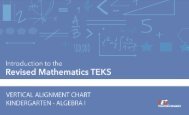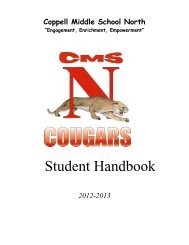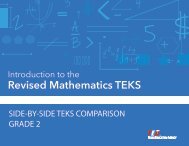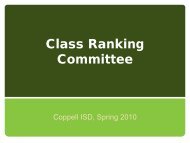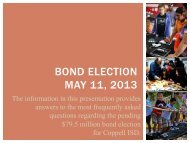SIDE-BY-SIDE TEKS COMPARISON GRADE 3 - Project Share
SIDE-BY-SIDE TEKS COMPARISON GRADE 3 - Project Share
SIDE-BY-SIDE TEKS COMPARISON GRADE 3 - Project Share
You also want an ePaper? Increase the reach of your titles
YUMPU automatically turns print PDFs into web optimized ePapers that Google loves.
Grade 3 – MathematicsCurrent <strong>TEKS</strong> Revised <strong>TEKS</strong> (2012) Supporting Information Notes(a) Introduction.(1) Within a well-balanced mathematicscurriculum, the primary focal points at Grade 3are multiplying and dividing whole numbers,connecting fraction symbols to fractionalquantities, and standardizing language andprocedures in geometry and measurement.(a) Introduction.(2) Throughout mathematics in Grades 3-5,students build a foundation of basicunderstandings in number, operation, andquantitative reasoning; patterns, relationships,and algebraic thinking; geometry and spatialreasoning; measurement; and probability andstatistics. Students use algorithms foraddition, subtractions, multiplication, anddivision as generalizations connect to concreteexperiences; and they concretely developbasic concepts of fractions and decimals.Students use appropriate language andorganizational structures such as tables andcharts to represent and communicaterelationships, make predictions, and solveproblems. Students select and use formallanguage to describe their reasoning as theidentify, compare, and classify two- or threedimensionalgeometric figures; and they usenumbers, standard units, and measurementtools to describe and compare objects, makeestimates, and solve application problems.Students organize data, choose an appropriatemethod to display the data, and interpret thedata to make decisions and predication andsolve problems.(a) Introduction.(1) The desire to achieve educationalexcellence is the driving force behind theTexas essential knowledge and skills formathematics, guided by the college andcareer readiness standards. Byembedding statistics, probability, andfinance, while focusing on computationalthinking, mathematical fluency, and solidunderstanding, Texas will lead the way inmathematics education and prepare allTexas students for the challenges theywill face in the 21st century.(a) Introduction.(4) The primary focal areas in Grade 3 areplace value, operations of whole numbers,and understanding fractional units. Thesefocal areas are supported throughout themathematical strands of number andoperations, algebraic reasoning, geometryand measurement, and data analysis. InGrades 3-5 the number set is limited topositive rational numbers. In number andoperations, students will focus on applyingplace value, comparing and orderingwhole numbers, connecting multiplicationand division, and understanding andrepresenting fractions as numbers andequivalent fractions. In algebraicreasoning, students will use multiplerepresentations of problem situations,determine missing values in numbersentences, and represent real-worldrelationships using number pairs in a tableand verbal descriptions. In geometry andmeasurement, students will identify andclassify two-dimensional figures accordingto common attributes, decomposecomposite figures formed by rectangles todetermine area, determine the perimeterof polygons, solve problems involvingtime, and measure liquid volume(capacity) or weight. In data analysis,students will represent and interpret data.The definition of a well-balanced mathematicscurriculum has expanded to include theCCRS. A focus on mathematical fluency andsolid understanding allows for rich explorationof the primary focal points.The 2012 paragraph that highlights morespecifics about grade 3 mathematics contentfollows paragraphs about the mathematicalprocess standards and mathematical fluency.This supports the notion that the <strong>TEKS</strong> areexpected to be learned in a way thatintegrates the mathematical processstandards to develop fluency.The 2012 paragraph has been updated toalign to the 2012 grade 3 mathematics <strong>TEKS</strong>.The 2012 paragraph highlights focal areas ortopics that receive emphasis in this gradelevel. These are different from focal pointswhich are part of the Texas Response toCurriculum Focal Points [TXRCFP]. “[A]curriculum focal point is not a single <strong>TEKS</strong>statement; a curriculum focal point is amathematical idea or theme that is developedthrough appropriate arrangements of <strong>TEKS</strong>statements at that grade level that lead into aconnected grouping of <strong>TEKS</strong> at the next gradelevel” (TEA, 2010, p. 5).The focal areas are found within the focalpoints. The focal points may represent asubset of a focal area, or a focal area mayrepresent a subset of a focal point. The focalpoints within the TXRCFP list related gradelevel<strong>TEKS</strong>.©2013 Texas Education Agency. All Rights Reserved 2013 Introduction to the Revised Mathematics <strong>TEKS</strong>: Side-by-Side <strong>TEKS</strong> Comparison 1






